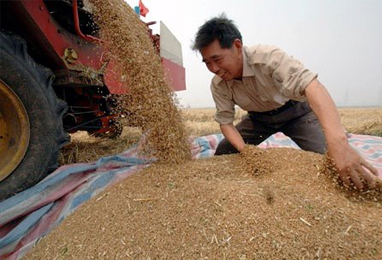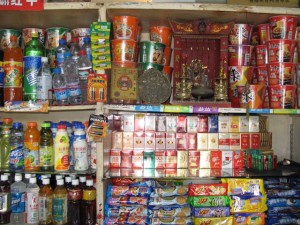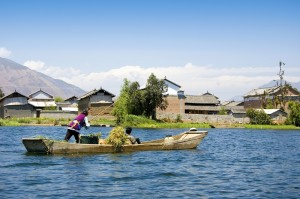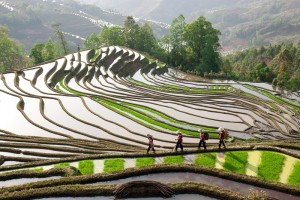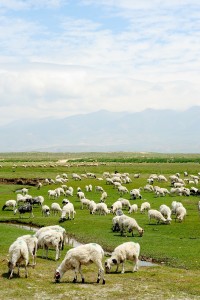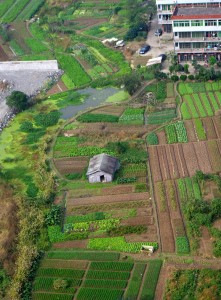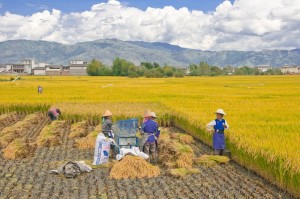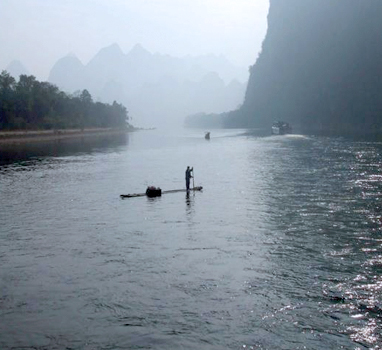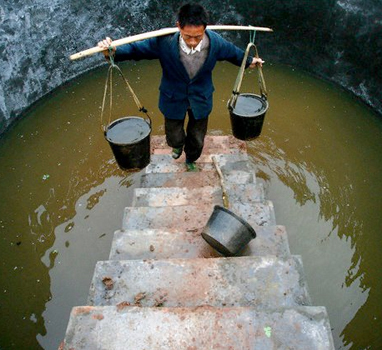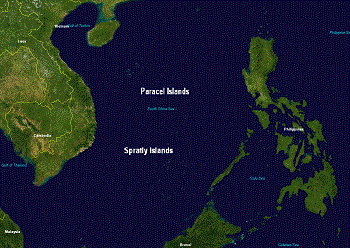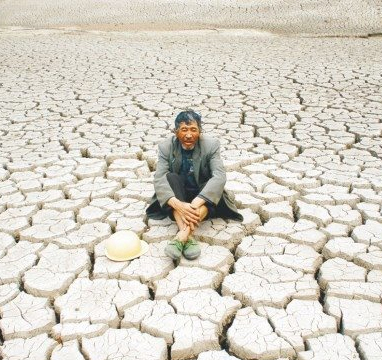Agriculture and Food Security: A Long-Term Priority
- Introduction
- China’s Agriculture under Mao Zedong
- Agriculture during the Reform Era
- Maintaining Grain Yields – Water and Pollution Challenges
- Maintaining Future Grain Yields – Small Farms
- Insuring Safe Food
- GMO in China
- The Automation of Agriculture
- China’s Growing Presence in Agriculture Abroad
- Future Trends
Introduction
Throughout China’s thousands of years of history, famines have often led to rebellions and instability which in turn has led to many a dynasties downfall. Therefore, ensuring food security in China has been both a priority for Chinese leaders throughout the ages, and it remains a priority for the Chinese Communist Party today. China’s challenge is that it supports approximately 19% of the world’s population on approximately 9% of the world’s arable land and 7% of the world’s fresh water. Despite these constraints, China has met its food needs through a policy of agricultural self-sufficiency. Today, China is the world’s leading producer of rice, wheat, and soybeans, the world’s second largest producer of corn and the seventh largest producer of sorghum. Additionally, China is the world’s largest producer of pork, the third largest producer of chicken and the 10th largest producer of beef.
That said, China’s ability to maintain continued growth in agricultural output is under threat unless there is further reform in the agricultural sector. Increased urbanization, plateauing yields, water shortages, small farm sizes and uncertain property laws are all making it difficult for China to continue to increase agricultural production. China’s 13th Five Year Plan (2016-2020) recognizes these challenges. Investing in hybrid seed research, repairing and improving on irrigation infrastructure, reclaiming rural land that has been lost to environmental degradation, shoring food safety mechanisms, expanding agricultural mechanization, and increasing the use of agricultural technology in order to improve yields have all been stated as clear priorities. The plan also recognizes the continued need to invest in rural areas of the country, so that China’s remaining farmers can earn a reasonable living and adequately invest in their children’s future within and beyond the farm sector.
In addition to investing domestically, China is significantly increasing its investment in agriculture abroad. According to a United States Department of Agriculture 2018 report, “1,300 Chinese enterprises had overseas investments in agriculture, forestry, and fisheries valued at $26 billion in 2016. The investments include crop and livestock farming, fishing, processing, farm machinery, inputs, seeds, and logistics in over 100 countries.” These investments have primarily been focused in the regions of Southeast Asia, Russia’s Far East, Ukraine, Africa, Australia, and New Zealand.
China’s Agriculture under Mao Zedong
When the PRC was founded in 1949 its new leaders continued to support a policy of agricultural self-reliance. This agricultural policy was driven by Mao Zedong’s view that the post-World War II order, with its corresponding American ascendancy, was potentially aggressive and imperialistic. Under this view dependency on grain imports risked making China vulnerable to having its food needs being turned into a weapon against it. In addition, Mao wished to use his country’s limited foreign exchange resources to purchase industrial plant and equipment rather than food, aiming for rapid industrialization. Indeed, until the famine caused by the Great Leap Forward (1958-1961), China exported grain to the Soviet Union in order to purchase plant and heavy equipment, at the expense of providing adequate per capita calories for its citizens at home.
Agriculture thus became the basis on which China’s planned economy was built. As China transitioned to a planned economy, the Communist planners began to underprice farm products relative to heavy industrial goods. This was because the planners were trying to ensure that the industrial sector produced high profits which could be plowed back into industry. To keep industrial profits high, costs had to be kept low; the most easily affected cost was labor. In order keep wages low, food needed to be cheap. Thus, farming became the key to the success of the entire Chinese planned economy. To achieve China’s goals, soon after he took power in 1949, Mao orchestrated the largest act of expropriation in world history. Approximately 200 million acres of land were taken from wealthy landowners and redistributed to nearly every peasant family in China. An estimated two million landlords lost their estates, sometimes through violence and almost never with compensation. Mao soon undercut this mass creation of private land ownership by implementing socialist policies of collective agriculture. The launch of the First Five Year Plan in 1953 saw farmers organized into cooperatives where they pooled their land and shared the proceeds. Under the collective structure, each farmer kept title to his land and was paid both labor wages and a dividend based on the value of the land contributed to the collective. After some success under the cooperative model, Mao went further. In 1958, Mao began to move farmers into communes to gain greater control of agricultural output. Mao believed that communes would generate greater farm output as it allowed an increased usage of irrigation and mechanization. As an added benefit, the surplus farm labor that would theoretically be created by collectivization could then be redeployed into the rural and urban industrial sectors. He also believed that healthcare and education for the rural citizens could be more easily delivered in a collectivized environment. Just as importantly, communes would be an effective platform for mass political indoctrination. Mao’s communes pursued a “grain first policy” in which basic crops such as rice, wheat, and corn were planted regardless of the suitability of the soil and other conditions. The shift to communes eliminated household farming, except on small family plots, and all land ownership transferred to the state.
As a result of Mao’s policies, from 1952 to 1978, China increased industrial production as a percentage of national income from 19.5% to 49.4%. Grain production rose by 86%, an average annual increase of 2.5%. However, grain production increased at a rate about equal to him population growth, meaning that average grain output per capita stayed roughly steady during this period. China also increased the production of cash crops by 16%. Up until 1960, China exported grain, peaking at 5 million tons in 1958. After the famine of the Great Leap Forward, China began to import grain, yet these imports averaged 1.6% of total consumption, meaning that China was almost completely self-sufficient in food under the planned economy.
These statistics, however, are deceptive. Much of Mao’s industrial development was inefficient. Poor economies of scale, inadequate transport, and poorly skilled labor meant that China’s huge industrial investment generally failed to effectively build upon China’s existing industrial base, although its development of human capital skills and rudimentary infrastructure did lay the foundations for broader industrialization during the Reform Era. Throughout the socialist period, Chinese consumers remained on strictly rationed diets consisting primarily of coarse grains. Most consumers were deprived of daily access to cooking oil, sugar, meat, and vegetables for extended periods. In the 1970s, despite increases in grain production, urban residents ate an average of 2,328 calories per day, while rural intake was even lower at 2,100 calories daily. Average grain output per capita remained virtually unchanged and the absolute poverty rate hovered between 30% and 40%.
The primary weakness of communes was the absence of incentives. Farmers did not keep produce from their lands, which undermined their work effort. Instead, commune members were given work points based on tasks; these points were converted to grain and cash pay-outs at the end of each crop year. Free riding and an inability to monitor agricultural labor became endemic. Output also suffered because decision-making was concentrated in the hands of collective leaders who themselves were frequently following dictates from above, stifling any prospect for innovation. The pricing during this era also did little to encourage the efficient production or allocation of goods and services. Additionally, agricultural inputs such as fertilizer were in constant short supply. Because of the hukou housing registration system (which, while more relaxed, remains in force today), farm labor had no opportunity to move from agriculture to industry as the hukou system completely restricted the mobility of China’s people. This entrapment of Chinese villagers in rural areas effectively designated them as second-class citizens.
Agriculture during the Reform Era
After 1978, a series of reforms was introduced into the rural sector to improve its economic performance. One step was to de-collectivize Chinese farmers into what was termed the Household Responsibility System, where the government leased agricultural land to households. The government then raised the prices that farmers would receive by 41% for grain and by around 50% for cash crops for any farm output farmers produced above mandatory quota deliveries. Initially, the state purchased all grain sold by farmers above quotas. Eventually, private agricultural markets were re-established. Greater freedom of choice was allowed in terms of the types of crops cultivated. Fertilizer and new high-yield seed usage became more widespread. The result was a surge in agricultural output. Grain output swelled from 304.8 million tons in 1978 to an estimated 650 million tons in 2018.This growth reflected a significant rise in crop yields as grain sown area has increased at a smaller rate than crop yields. In 1978, China had approximately 120.6 million hectares under plow; in 2017, this figure increased to approximately 135 million hectares. Overall, it is China’s stated goal to maintain cultivated land at around 124 million hectares. Rising crop yields have resulted in grain price reductions. Since 1978, maize prices decreased 33% and wheat 45%. Coupled with rising incomes, these decreases meant that grain, as a percentage of rural and urban household consumption, fell from 40% and 20% respectively in the late 1970s to about 14% and 3% in 2004. These higher yields and lower prices have resulted in more food per capita. Per capita caloric intake rose from 2328 calories per day in 1980 to an excess of 3,000 calories per capita per day by 2008.
Additionally, since 1978, China’s agricultural output became significantly more diversified. Chinese farmers have moved into labor-intensive cash crops such as aquaculture, cotton, edible oils, fruits, and vegetables. Between 1978 and 2007, for instance, crop farming went from 80% of agricultural gross value output to 50.4%, while animal husbandry and fisheries increased from 16.6% to 42.1%. Between 1990 and 2004, China’s vegetable output expanded so quickly that China added the equivalent of California’s vegetable industry every two years in, and orchards now cover over 5% of China’s farmed area, double the share of any other major agricultural nation. As a result of this diversification, the Chinese diet has come more varied. Most Chinese households consume a more varied diet adding meat, poultry, fish, eggs, a variety of vegetables and dairy produce to their diets.
Maintaining Grain Yields – Water and Pollution Challenges
Throughout this period of reform, China maintained its policy of grain independence, never importing more than 5% of its grain needs. As stated in China’s 13th Five Year ensuring basic self-sufficiency of grain and absolute security of stable food remains a clearly stated goal. That said, with 19% of the world’s population being supported by approximately 9% of its arable land, this goal remains challenging. This means that China does not have a comparative advantage in land intensive products such as grain. Moreover, China’s population will continue to rise until around 2035, meaning that China will need to increase yields in order to maintain current grain per capita levels. Furthermore, as China continues to urbanize, more of its usable land will be refashioned into cities and supporting infrastructure. Additionally, pollution, soil erosion and desertification continue to negatively impact the agricultural land that is available. As a result, it is estimated that by 2050, the total demand for arable land will outstrip supply by more than 12%.
Part of the reason that China achieved such high grain production over the last two decades was yield improvements driven by the use of new high-grade seed varieties and by massive inputs of chemical fertilizer. Yet further benefits from these inputs are beginning to diminish. In 1975, total fertilizer usage was 5.5 million tons, but this rose to 47.7 million tons by 2005. China’s per hectare fertilizer usage was second only to Japan in the 1990s. Overall, it is estimated that China uses 30% of the world’s fertilizers and pesticides on 10% of global farmland. Fertilizer saturation is such that previously good or excellent soils are cresting, hardening and becoming devoid of organic material such that further application of fertilizers is leading to diminishing crop yields as well as causing considerable environmental problems such as eutrophication and particle pollution in the air. Yield benefits from the extensive use of plastic are also plateauing. Finally, large-scale deforestation has led to soil erosion.
Water shortages and water pollution may also limit future yields unless China is able to implement significant reforms in its water management. China’s freshwater of approximately 2156 m³ per capita is less than one third of the world average. This is projected to decrease to 1875 m³ by 2033. Water shortages are expected to worsen as current water demand is still relatively low at 461 m³ per capita compared with the world average of 645 m³, but this number is projected to reach 665 m³ by 2030. Water shortages will be worse in the arid and semi-arid areas in China’s northern plain from which much of the future grain output growth will be generated. In addition to water shortages, problems with irrigation system will also stymie yield growth. During the Mao-era, irrigated area tripled. Since de-collectivization, the irrigation system has deteriorated. With the reversion to family and commercial farming, control of the irrigation system has fragmented, and it is harder to mobilize mass labor for maintenance and construction. The introduction of water fees in the 1980s was designed to encourage more efficient water usage, but the fees were not sufficiently high to have the desired effect. Water designated for agricultural usage continues to be subsidized at a far higher rate than it is for industry and household use, and raising agricultural water fees remains politically difficult. Moreover, the collection of water use data remains imperfect, thus further challenging China’s ability to effectively price water used for agricultural purposes. Going forward, increasing water charges it is likely to be an essential step to dealing with China’s water shortages.
As water becomes increasingly scarce, the agricultural sector will continue to compete with the industrial sector and with households for scant water resources. According to the Ministry of Water Resources China now uses as much as 60% of the water running in many of its rivers, including the Liao and Yellow Rivers, and as much as 90% of the Huai River. China has increasingly turned to aquifers and lakes to meet water demands no longer satisfied by rain and river water alone. Groundwater now provides potable water for nearly 70% of China’s population and irrigation for approximately 40% of its agricultural land in China’s dry northern and northwestern regions. Nationally, groundwater usage has almost doubled since 1970, and now accounts for almost 20% of China’s total water usage.
Due to an uneven distribution of water resources between the north and the south of China, aquifers are especially important in China’s north, where farmers have been relying heavily on groundwater resources to increase agricultural yields. Yet China is now draining its aquifers at an unsustainable rate. At current rates of depletion, the World Bank estimates that China’s northern aquifers could effectively run dry in as little as 30 years or less. China’s northern megacities now rely on underground water sources for two-thirds of their needs. For example, in Hebei province, which surrounds Beijing, aquifer levels are dropping by approximately 3 meters annually, forcing the digging of ever deeper wells. These deeper wells in turn increase both the risk of both saltwater and arsenic intruding into the water supply and likelihood of land subsidence. With aquifers and rivers suffering from overuse, lakes are also diminishing. The province of Hebei, for instance, has already lost a staggering 969 of its 1052 lakes. While China’s ‘Water Pollution Prevention & Control Action Plan’ has establish targets to restrict ground water extraction and groundwater pollution by 2020, water restriction measures have both proved unpopular and hard to enforce.
Pollution is also challenging China’s agricultural output. China’s use of coal that is high in sulfur and heavy metals to power many of its electricity plants. The pollution from these power plants combined with additional industrial and agricultural pollution contaminate both China’s soil, air, and water. In the north, for instance, the same northern provinces that accounted for 55% of China’s farmland also hold 86% of its coal reserves yet have just 16% of China’s water resources. In the south, over 50% of China’s rice is grown in provinces which account for 52% of its arsenic, 58% of its mercury and 72% of its chromium discharges.
Maintaining Future Grain Yields – Small Farms
China’s future yield growth is also hampered by the small area plowed by each farmer, averaging .65 hectares or 1.6 acres. While de-collectivization from large communal plots to small family farms initially led to a surge in output growth, the segmentation of communal plots is now proving a constraint on grain yields. It has been estimated that increasing farm sizes could increase grain output by as much as 70 million tons annually. Small farm sizes restrict growth by preventing farmers from capturing economies of scale that could be derived from greater mechanization, from the more efficient dissemination of new seed technologies and from the improved maintenance of irrigation structures. Small farms also make it more challenging for farmers to participate in modern supply chains, to offset market volatility and to adapt to climate change, Additionally, small farms tend to use fertilizers and pesticides inefficiently. Research by Nerissa Hannik found that a 1% increase in farm size was linked to a .3 and a .5% decrease in fertilizer and pesticide use per hectare, respectively. Excessive use of fertilizers and pesticides in turn pollute soil and water which in turn depresses crop yields.
Small farms drive down rural incomes. As approximately 35% of Chinese workers or about 311 million people were employed in agriculture in some form in 2017, the impact on rural incomes is significant. In 2018, the annual per capita disposable income of urban and rural households in China was 39,251 and 14,617, respectively. Reduced rural economic opportunity in turn dis-incentivizes younger and more educated workers from pursuing a career in agriculture As a result, the average age of the Chinese agricultural worker is higher than the age of Chinese workers generally and is increasingly less educated than his urban counterpart. Older, less educated farmers could cause structural stagnation in the agricultural sector. Such farmers may fail to adopt new technologies, innovate, and adapt to changing market conditions.
The fact that farmers lease – as opposed to own – their land has also worked to constrain grain yield by discouraging long-term investment and growth in land size. Individuals cannot privately own land in China but can acquire transferable land-use rights for some number of years. Currently, for example, land-use rights for residential purposes is 70 years. All farming or rural land is owned by rural collectives which distribute contract rights for plots of farmland to eligible households. The first leases issued in 1983 were for a duration of 15 years. These were renewed in 1997 for 30 years and again in 2017 for an additional 30 years. As part of its land-use contract, Chinese farmers have the right to decide which crops to plant, to keep all agricultural proceeds, and to sublease their land to others for agricultural production. Chinese farmers are prohibited from using contracted land for non-agricultural purposes, to leave their land fallow for more than two years or to legally oppose the government if it decides to acquire the property for development purposes. To help improve rural household stability, in 2003, China passed the Rural Land Contract Law. The law endeavors to improve the security of land tenure, to clarify the transfer and exchange rights of contracted land, and to permit family members to inherit land during the contracted period. Above all, the law reflects the government’s attempts to allow those staying in farming to gain access to additional cultivated land and to increase their incomes and competitiveness. It strives to encourage farmers to use the land more efficiently.
Working against government efforts to improve plot size, however is the belief by some Chinese leaders that family farming provides at least nominal proof that China is still communist as its land is not privately held, and as its land is relatively equally distributed. Many Chinese leaders also believe that agricultural land provides a social security system for its population, as every rural family is theoretically only one season away from being able to feed itself.
That said, the fact that the government no longer plays a significant role in agricultural production. Aside from restrictions on land ownership, China today has one of the least distorted domestic agricultural economies in the world. Most grains, oilseeds, and fiber crops, and all horticultural and livestock products are sold to small private traders who compete in efficient and integrated markets with minimal regulation.
Insuring Safe Food
In 2008, Chinese domestic milk and infant formula was found to have been purposely tainted with melamine, sickening 300,000 babies, and killing six. Other food scandals include contaminated pork, fake eggs, gutter oil, and counterfeit foods mislabeled as brand name or organic products. These scandals have caused many Chinese to express serious reservations about the quality of domestic food sources and to call for industry reform. The 13th Five Year Plan addressed these concerns by committing to upgrade agricultural standards and to ensure the quality and safety of all food products over the entire journey of agricultural products from farm to table.
In May 2019, the Chinese Communist Party reinvigorated this goal when China declared that it would be stepping up its enforcement of food safety legislation as part of the Communist Party’s campaign called “Staying True to Our Founding Mission”. Between June and December 2019, its increased efforts have resulted in the identification of 70,000 food safety violations, culminating in the suspension of over 2400 food manufacturers and the meting out of approximately $130 million in fines. Additionally, China is increasingly implementing technologies such as sensors, artificial intelligence, and block chain IDs to improve the traceability of food products from farm to table. Other measures include increased supervision with more random checks and the tightening of food safety standards. By 2035, it is China’s goal to have in place world-leading food safety standards and globally advanced risk control capabilities.
GMO in China
Genetically engineered or transgenic organisms, also known as genetically modified organisms (GMOs), were first made available to US consumers in 1994. By 2014, approximately 28 countries sowed GM crops on more than 181 million hectares, equaling 13% of the world’s arable surface. GM soybeans, cotton, maize, oilseed, and rape account for approximately 82%, 68%, 30% and 25% of the total planted area for these crops, respectively. In 2015, the United States Food and Drug Administration authorized the first genetically modified animal for human consumption.
Advocates of GMO food note that such crops could help the world adopt to changing climatic conditions including drought, cold and soil salinization. Additionally, by genetically coding in natural pesticides and other disease-resistant characteristics, GMO foods also offer the opportunity to fight off pests and diseases while correspondingly lowering the use of pesticides. Crops can also be modified to increase crop yields. Among their many concerns, opponents of GMO foods note that the long-term health consequences of consuming GMO food have yet to be determined. Additionally, opponents fear that GMO plants will diminish biodiversity by contaminating wild species.
Despite the risks of GMO plants, China’s 13th Five Year Plan sets as a goal to develop a modern seed industry, including the development superior seed varieties, and cultivation breeding-promotion operations. In January 2020, the Chinese government stated that genetically modified corn, cotton, and soybean species had passed biosafety evaluations, inching the country closer to commercialization of new GMO food sources. These crops were modified to be more resilient against disease and pests. On paper, China has approved biotech cotton, papaya, tomatoes, sweet peppers, petunias, and poplar trees. However, commercialization has been allowed only for papaya and cotton.
In 2018, the global market value of GM crop seeds was $20.1 billion and is expected to grow to $30.2 billion by 2026. As one of the world’s leading countries in the research and development of agricultural biotechnology, China’s issue of bio certificates for soybeans, cotton and corn indicates its interest in capitalizing on its billions of dollars of investment in the field, including its $43 billion purchase of the Swiss pesticide giant Syngenta in 2016. Not only would China benefit from commercializing its GMO seeds to sell globally, but many studies have indicated that China would also enjoy substantial economic benefits from the cultivation of GMO food crops domestically.
The commercialization of China’s GMO technology has been hampered, however, by the Chinese public’s negative attitude toward GMO crops. As per a 2010 online survey interviewing 50,000 people, about 84% of respondents said that they feared GM foods for safety reasons. A 2018 nationwide survey found that those views had not substantially shifted with 46.7% of respondents expressing negative views of GMOs and with 14% considering GMO products to be form of bioterrorism targeting China.
The Chinese public’s disapproving views concerning GMO products likely originate from their experience of the various food scandals that have plagued the country. This adverse experience has likely also negatively impacted their views of genetically modified foods. Exacerbating their concerns has been the discovery that GMO food products have already been farmed illegally in China. In 2014, China Central Television (CCTV) tested five bags of rice from a Wuhan supermarket in Hubei province, and discovered that three of the five samples had been grown from genetically modified seeds. In the same year, illegal large-scale planting of GMO rice and corn in four provinces were reported. In 2016, it was revealed that 93% of corn from Liaoning province demonstrated traces of GMO contamination. In response, the government destroyed crops, confiscated illegal seeds, and prosecuted perpetrators.
The Chinese government is now working to change Chinese opinion regarding GMO products. Given what is at play, the stakes could not be higher. Not only has China made massive investments in the technology that it now wants to commercialize, but water shortages, climate change and its growing population will continue to place unprecedented pressure on its food supply. GMO products can help China adapt to these challenges. GMO crops should also enable China to reduce its extremely high use of fertilizers and pesticides which in turn will have positive impacts on its environment and food supply.
The Automation of Agriculture
While the percentage of the Chinese workforce involved in farming has decreased from 55% in 1991 to 18% in 2017, approximately 250 million Chinese still work as farmers. However, as China’s rural young becomes increasingly educated, and as China’s economy continues to expand, many are migrating to urban areas seeking better opportunity. As a result, approximately 60% of people working in Chinese agriculture are over 45 years compared to just 14% of farmers who are less than 35 years. This decline in farm labor is projected to increase over the coming decades even as China’s population is projected to continue to grow through 2035. Contemporaneously, China’s population is expected to become wealthier. Growing wealth correlates with a rising consumer demand for greater food variety and for more animal-based proteins. The water footprint per calorie pulses, eggs, chicken, pigs, sheep, and beef is 2.5, 2.0, 2.6, 3.6, 5.3, and 9.4 times larger than grains, respectively. This increase in water per calorie will further stress China’s polluted and limited per capita water supply.
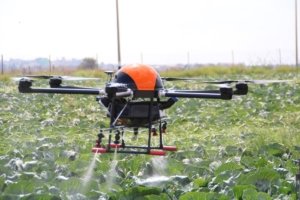 China is answering these challenges by significantly investing in agricultural technologies including artificial intelligence, big data, robotics, and automation. Not only will these technologies help improve the efficiency and sustainability of China’s agricultural market, but they also represent a big and rapidly growing global business. The market for global agricultural robots, for instance, is projected to exceed $20 billion by the end of 2025, with growth in precision agriculture as a major driver. Artificial intelligence, automation, big data, and robotics are expected to find applications in everything from herding and fish farming to planting and harvesting. Other uses include seeding, irrigation, water leak detection, fertilizing, crop weeding, spraying, crop monitoring and analysis, disease and pest identification and eradication, thinning and pruning, and tracking the growth of plants. In addition to robotics, drones are also increasingly being used to monitor crops, conduct field analysis, manage livestock, plan interrogation and crop spraying. Drones aid farmers to see the big picture of their farmland and to make educated decisions that help to maximize crop yields.
China is answering these challenges by significantly investing in agricultural technologies including artificial intelligence, big data, robotics, and automation. Not only will these technologies help improve the efficiency and sustainability of China’s agricultural market, but they also represent a big and rapidly growing global business. The market for global agricultural robots, for instance, is projected to exceed $20 billion by the end of 2025, with growth in precision agriculture as a major driver. Artificial intelligence, automation, big data, and robotics are expected to find applications in everything from herding and fish farming to planting and harvesting. Other uses include seeding, irrigation, water leak detection, fertilizing, crop weeding, spraying, crop monitoring and analysis, disease and pest identification and eradication, thinning and pruning, and tracking the growth of plants. In addition to robotics, drones are also increasingly being used to monitor crops, conduct field analysis, manage livestock, plan interrogation and crop spraying. Drones aid farmers to see the big picture of their farmland and to make educated decisions that help to maximize crop yields.
Improving agricultural sustainability is another factor motivating China’s adoption of agricultural technology. China’s farming industry has a significant carbon footprint, with Chinese farmers using 30% of the world’s fertilizers and pesticides on 9% of global farmland. In addition to developing drones and robots that can help to reduce fertilizer and pesticide needs, Chinese scientists are also turning to big data to determine best farming practices. Over 20 million farmers have since benefited from China’s big data research; it is estimated the findings have enabled farmers to increase yields while slashing fertilizer use generating total financial savings of an estimated $12 billion.
China’s Growing Presence in Agriculture Abroad
 In the coming decades, China will face of an increasing divergence between demand for food and its ability to produce that food domestically. This divergence is driven by factors such as a population that will continue to grow through at least 2035, a more wealthy population that is demanding a more varied and a more meat-based diet, and limited and polluted land and water resources. As a result, China is increasingly looking to international markets to meet its food shortfalls.
In the coming decades, China will face of an increasing divergence between demand for food and its ability to produce that food domestically. This divergence is driven by factors such as a population that will continue to grow through at least 2035, a more wealthy population that is demanding a more varied and a more meat-based diet, and limited and polluted land and water resources. As a result, China is increasingly looking to international markets to meet its food shortfalls.
According to the United States Department of Agriculture’s 2018 report, in 2016 an estimated 1,300 Chinese enterprises had made overseas agriculture, forestry, and fisheries investments in over 100 countries. These investments were valued at approximately $26 billion. The investments were placed in a variety of sectors including land purchase, land leasing, seeds, farm inputs, farm machinery, food processing, farm logistics, farm machinery, livestock farming, and fish farming. China’s National Bureau of Statistics noted that Chinese investment in foreign farming, forestry, and fishing grew fivefold from 2010 to 2016. Many of China’s agricultural investments are now made in conjunction with its China’s Belt and Road Initiative.
As has been the case in other foreign investment sectors, China’s government has supported this international investment by favorable lending, brokering deals, formulating strategic plans which support low-cost bidding, and providing Chinese agricultural investors with training and information services. China subsidizes these investments for both political and economic reasons. Economic aims include the continued growth of the Chinese economy, securing access to raw materials, the expansion of exports, helping Chinese companies garner a larger share of profits from imported commodities, creating new markets for Chinese products, enabling tariff-free access to developed markets, shifting some of Chinese domestic manufacturing and domestic agriculture overseas, providing domestic companies with international experience, food security, gaining and imparting technical and managerial experience, and exerting influence on global prices. Political objectives include the preservation of the Communist Party rule, reestablishing China’s place as a leading world power, the promotion of multi-polarity, countering US hegemony, increasing Chinese influence in multinational institutions such as United Nations and World Bank, strengthening its alliances with other countries, particularly in the Third World, preventing Taiwan independence, and projecting political influence abroad.
Future Trends
There will be several trends to watch for in the Chinese agricultural sector in the coming decades. Firstly, China will make every effort to maintain its agricultural yields and its food self-sufficiency. Despite its rapid rate of urbanization, China is committed to maintaining a baseline for cultivated land area at 124 million hectares. It is investing heavily in agricultural research to increase yields and is launching a campaign to win public support for the introduction of more GMO crops.
China is also committed to increasing the sustainability of its agriculture and the safety of its food supplies. China is investing heavily in big data, drone technologies, artificial intelligence, and automation to reduce its use of pesticides, fertilizer, and water. Upgrading antiquated and leaking irrigation networks is a high priority. China is also using technology to start tracking its food as it journeys from farm to table; therefore, when food safety breaches arise, it can more effectively follow the breach back to the source. China will also continue to improve its food safety both through increased inspections, and better safety practices and standards.
China will also carry on investing in international agricultural, livestock and aquaculture food chains. These investments will help China ensure reliable and secure overseas food resources. They will also help to increase global food production overall, therefore helping to keep in check global food prices.
Finally, as the number of Chinese working as farmers further declines over the coming decades, China will likely begin to amalgamate its millions of small farms into increasingly larger parcels. Increasing farm sizes will free labor to work in areas which will provide China a higher return on labor capital. Larger farm sizes will also increase productivity by creating more opportunity for mechanization, and by reducing demand for farm inputs such as pesticides and fertilizers.

